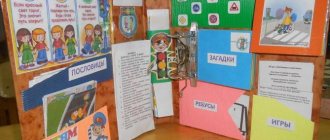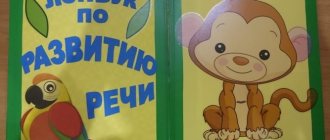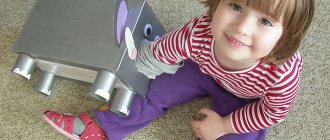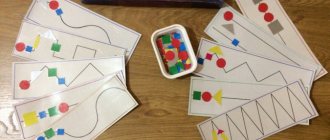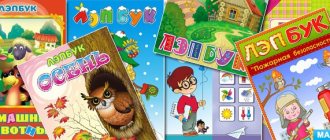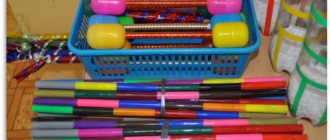Didactic game “Funny Kids”
Purpose : Differentiation of sounds S-Sh.
Game description:
Option 1.
Goal: differentiation of S-SH sounds in syllables.
Equipment: pictures of kids with soap bubbles, pictures of soap bubbles with syllables.
Progress of the game:
Speech therapist: Meet these cheerful kids Sonya and Misha. They love to play with soap bubbles, but kids are just learning and the bubbles turn out to be small. Do you want to play with them? Then take the bubble and repeat after me (if the child can read, then he pronounces it himself).
Sample: Sa - sha, so - sho, su - shu, sy - shi.
Option 2.
Goal: differentiation of sounds S-Sh in words and phrases.
Equipment: pictures of kids with soap bubbles, pictures of paired colored soap bubbles with subject pictures.
Progress of the game:
The speech therapist lays out two soap bubbles of the same color, asks the child to turn them over and name what is depicted on them.
Sample: Teddy bear - bowl, fluff - sock.
Ask the child to name who did what happened.
Sample: Sonya has a bear - Misha has a bowl
Option 3
Goal: differentiation of S-SH sounds in phrases and sentences.
Equipment: pictures of kids with soap bubbles, pictures of soap bubbles with object pictures.
Progress of the game:
Speech therapist: For Sonya we will choose bubbles with pictures in the name of which you can hear the sound Ш, and for Misha in which you can hear the sound S. Choose a bubble and name who it is for.
Child: Cat for Sonya; a dog for Misha...
Speech therapist: name everything that Sonya and Misha did.
Child: Sonya has a cat, a puck, a hat, a fur coat, and a car.
Misha has a dog, a sled, boots, a bag, and a jump rope.
Speech therapist: Do you think all subjects are suitable for Sonya and Misha? Let the guys swap what doesn't suit them.
Child: Sonya will give Misha a car, and Misha will give Sonya a jump rope. Misha will give Sonya the sled, and Sonya will give the puck to Misha. Misha will give Sonya the bag, and Sonya will give Misha the hat.
Speech therapist: How have the kids changed?
Child: The kids swapped a car and a jump rope. The kids swapped sleds and pucks. The kids exchanged bags and hats.
Option 4
Goal: differentiation of S-SH sounds in words.
Equipment: a picture of a baby with soap bubbles, pictures of large soap bubbles with words.
Progress of the game:
Speech therapist: Sonya and Misha have a friend Sasha. Do you want to meet him? He will teach you how to blow big bubbles. Choose a bubble and repeat after me.
Sample: I write - I carry, yours - you, awl - strength...
Didactic game "Locomotive".
Game description:
Option 1.
Goal: automation of sound Ch in isolation.
Progress of the game: Meet this magic train and he lives in a fairy-tale house. Do you want to visit him? Then take the little engine along the path and sing its song “ch-ch-ch”.
Option 2.
Goal: automation of the sound H in syllables.
How to play: The little engine has a lot of friends, do you want to meet them? Then set off, but at each station you need to stop and sing her song: cha-cha-cha, chu-chu-chu and so on. The time has come to go back and now the little engine and I will sing other songs: ach - ach - ach, uch - uch - uch and so on.
Didactic game "Autumn".
Game description:
Option 1.
Goal: automation of sound in isolation.
Progress of the game: Autumn has come and all the forest clearings are strewn with leaves. Do you know the sound of a brush? Sweep large leaves and pronounce the sound of the brush “sch – sch – sch”, then only green, yellow, small leaves and so on.
Look how many paths there are in the forest and they are all covered in leaves. Sweep the path with yellow leaves, now with brown ones, and so on.
Option 2.
Goal: automation of the sound Ш in syllables.
Progress of the game: All the leaves are collected in a pile, but you can scatter them in our magical clearing. Lead the brush along the paths and sing the brush songs: schuh, schuh, schuh, shchi. Now we need to put things in order. Let's collect the leaves: sch, sch, sch, esh.
Theatrical play activity of children during classes with a speech therapist
Speech therapy classes for children are not complete without the use of elements of theatrical play activities for preschoolers. You can make figurines for the theater yourself. This could be a finger theater. Masks of fairy-tale characters are made from paper, they are put on the finger, and the performance is performed. In the tabletop theater, fairy-tale characters made of cardboard are inserted into spools of thread. The shadow theater is also interesting. It requires a small white backlit screen and black action figures.
You and your children can come up with your own unusual fairy tales, where the heroes can be vegetables, fruits, and household items. Small theatrical performances bring joy, develop children’s imagination, strengthen memory, and make speech varied and correct.
Speech therapy games for children play a major role in the development of correct pronunciation in preschoolers.
DIY speech corner
A manual made with your own hands, supplemented, expanded to suit the needs of children and the goals of the lessons, will always be of much greater value and will make learning more effective and efficient.
In preschool age, the predominant type of activity is play, so the materials presented provide the opportunity to perform exercises in the form of a fun game that solves serious problems. The creation of the presented manuals allows children to independently or with the help of an adult perform exercises that develop fine motor skills,
phonemic hearing, as well as consolidate acquired knowledge in the classroom.
Didactic manual "House"
As you know, the development of speech is closely related to the development of fine motor skills, so speech corners are necessarily supplemented with the necessary aids for this: lacing, massage balls, su-jok balls, etc.
Boards for the development of fine motor skills are also found in speech therapy practice, but more often they are an open version, and if they have closed holes, then with the least functionality, because often only a picture follows the door, and besides, the open versions of such boards are less aesthetically pleasing. This “House” manual is made mostly of plywood to lighten the structure, and for strength and ease of fastening the parts with fasteners, stiffening ribs were used, and there are hooks on the back panel to securely fasten the manual to the wall. Closed elements add not only aesthetics to the manual and a surprise moment for the child, but also, among other things, allow you to save space, since various elements are located not on one long panel, but on two (external and internal), and the most functional one is neatly “hidden” " The manual attracts the child's interest and includes many different devices for the development of fine motor skills of a preschooler. “House” is a simulator for developing fine motor skills through various manipulations with a switch, socket, latch, lock, door chain, door hook, lids, and doorbell. The presented elements are interesting to the child because they are encountered in his life every day without a playful orientation. Here it is possible to carry out repeated manipulations without damaging household items, at the same time developing dexterity of the fingers, and the acquired muscle memory will be very relevant in everyday life. In addition, fine motor skills develop, and for children with speech pathology this is especially important (accuracy, speed and coordination of movements suffer, mainly in children with dysarthria). This means that speech develops indirectly and directly, because you can play not only on your own, training your fingers, but also with a teacher, pronouncing your actions, choosing the necessary antonym, listening and following instructions.
Didactic manual “Snail”
Speech therapy snails and their variants have become firmly established in the everyday use of speech therapists and educators in classes on speech development and automation of sound pronunciation.
My manual, having absorbed the positive qualities of such didactic materials, is distinguished by the natural raw materials from which it is made. In addition, the presence and sufficient number of medium-sized pockets, and this already solves the problem of selecting the necessary painting material without special material costs. Mobility, a variety of cards on lexical topics, and the ability to be included in individual and group lessons make this manual multifunctional. This didactic manual solves the following correctional and educational tasks: to teach to form generalizing concepts on various topics, to consolidate and expand the vocabulary on the same lexical topics.
Correction and development tasks:
- develop sound-letter analysis skills, generalization and systematization skills;
- automate the sounds in words;
- develop coherent speech skills through composing a story based on pictures.
Children happily fill out the “Snail” with pictures, naming them, correlating them with the topic of the lesson, while doing a small grammatical exercise (“name it affectionately”, “count to five”, “one-many”, “pick up a sign”).
Thus, in a lesson, this manual can be used at any stage: both as an organizational moment, and at the main stage, as an independent exercise, and at the final stage when summing up the results. This “Snail” serves as the basis for compiling a sequential story based on pictures, an addition to the familiarization and generalization of material on various lexical topics, and the consolidation of the given sounds in words in different positions. In this manual, picture material, which can be supplemented if desired, is selected not only for various lexical topics, but also for the following sounds in different positions (beginning, middle, end of the word): [р], [л], [ж], [ w], [h], [sch], [ts], [z], [s].
The games and exercises listed below are just a small example of how this manual can be used, because its main positive quality is its versatility of use in classes, both individual and group.
Games and exercises
— Exercise “Select pictures for a given sound.” Goal
: automate the delivered sound in words.
Objectives
: develop phonemic hearing; develop sound analysis skills.
— Exercise “Choose a picture with a given sound at the beginning, in the middle, at the end of the word.” Target
: automate the delivered sound in words in different positions.
Objectives
: develop sound analysis skills; develop phonemic hearing.
— Exercise “Choose a picture on a given topic.” Target
: consolidate words on the lexical topic being studied.
Objectives
: develop generalization and systematization skills; develop attention, memory, thinking.
— Exercise “Tell me according to the diagram.” Target
: to develop skills in writing a story using pictures.
Tasks
: consolidate words on the lexical topic being studied; develop the grammatical structure of speech through the coordination of words in a sentence; develop attention and memory.
Zhanna Glazkova, teacher-speech therapist, MADOU D/s No. 119 o.v. "The Nightingale", Magnitogorsk


